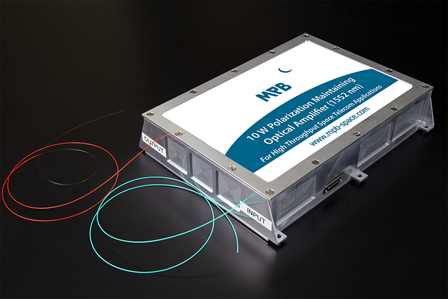
-
StatusCompleted
-
Status date2021-01-27
-
Activity Code5C.284
The objective is to develop a high power amplifier for high gain MxN intra-satellite cross-connection, high speed (>100 Gbps) inter-satellite links and satellite-Ground Link.
The amplifier power is 10W at end of life (EOL), in the telecom 1550 nm range, with Polarization-Maintaining fibres
The design had to overcome many challenges to comply with the mechanical, thermal, radiation, and vacuum requirements for the LEO satellite space environment, while at the same time meeting the price targets for LEO constellations by maximizing the use of commercial off the shelf (COTS) components.
The following were the main challenges:
- to effectively dissipate the heat generated (75-90 W);
- to select radiation tolerant Erbium and Erbium-Ytterbium Doped fibres
- to select radiation-tolerant electronics to drive the needed electrical current;
- to source and effectively implement components, such as the combiners and isolators, in the high-power optical path compatible with vacuum at 10W output.
- Avoid the Stimulated Brillouin Back-scattering (SBS) at 10W or higher power
- High power (10W) amplifier
- Compatible with space environment (radiation, vacuum, functionality over wide temperature range Radiation Tolerant.
- Faster intra-satellite MxN cross connection to replace the electrical wire and RF signals by optical fibres higher data transmission speed , with less mass and volume and more reliability
- Faster intersatellite data communication, with > 100 Gbps permitting image transfer in almost real time
- Using PM fibres permits to reduce the Noise and increase the transfer speed by a well selected RF signal modulation
- Improve the Bit Error Rate in the link between satellites and Ground, by permitting more photons /time step
An innovative, proprietary method was developed to satisfy this requirement.
The unit successfully passed performance testing between -20°C and +40°C in vacuum with 10W output, with a wall plug efficiency of 11%. The lower temperature limitation was due to the specification of the high-power laser diodes. The higher temperature was limited by the local heating and risk of mechanical breaking of the third-stage COTS combiner and isolator. The components used were available as COTS products, including the radiation-tolerant electronics. All the components were qualified individually for > 30 krad, in vacuum and for the temperature range -35°C to +65°C with the exception of the high-power laser diodes were limited to -25°C. MPBC is continuing the qualification, implementing minor design changes, in order to satisfy the complete temperature range (-35°C to +65°C).
The prototype is based on three stages of optical amplification with photodiodes at each stage, monitoring the output power. It includes the control electronics and software with feedback loops to dynamically control and monitor the amplifier.
The project tasks are summarized by the following:
- Review and Consolidate the Requirements for 10W EDFA-Polarization-Maintaining (PM) with the space primes and potential users
- Erbium, Erbium-Ytterbium Active Fibres Evaluation, with mainly gamma radiation test
- Amplifier Design (40 dBm EOL)- Modelling and simulation of by optical , mechanical and electrical performance
- Module Components Validation (40 dBm EOL)
- Optical Amplifier Module Prototyping
- 2nd Iteration and Prototype Validation (Vacuum, vibrations)
- Roadmap toward Commercial Products
COMPLETED
MPB has developed a 10W Polarization Maintaining Optical Fibre Amplifier (1550 nm) for space applications. The unit successfully passed performance testing between -20°C and +40°C in vacuum with 10W output, with a wall plug efficiency of 11%. The lower temperature limitation was due to the specification of the high-power laser diodes. The higher temperature was limited by the local heating and risk of mechanical breaking of the third-stage COTS combiner and isolator.



